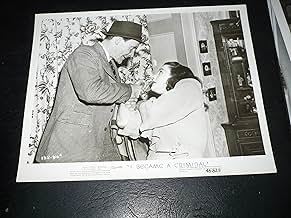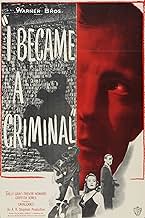Ajouter une intrigue dans votre langueAfter WW2, former RAF airman Clem Morgan joins a gang of black-market smugglers and thieves, but when a robbery goes wrong, Clem is caught, framed for a policeman's murder, and sent to priso... Tout lireAfter WW2, former RAF airman Clem Morgan joins a gang of black-market smugglers and thieves, but when a robbery goes wrong, Clem is caught, framed for a policeman's murder, and sent to prison, where he plots his escape and revenge.After WW2, former RAF airman Clem Morgan joins a gang of black-market smugglers and thieves, but when a robbery goes wrong, Clem is caught, framed for a policeman's murder, and sent to prison, where he plots his escape and revenge.
- Réalisation
- Scénario
- Casting principal
- Récompenses
- 1 nomination au total
Avis à la une
Also, the title begs comparison to the 1939 Warner Brothers picture THEY MADE ME A CRIMINAL and an early-thirties one called I AM A FUGITIVE FROM A CHAIN GANG. A typical American gangster movie from the thirties had a World War One vet who sells bootleg liquor during the Great Depression and THEY MADE ME A FUGITIVE makes the protagonist a World War Two vet dealing in rationed items such as cigarettes and liquor. There seems to have been a conscious effort, in the making of this movie, to capture the audience American gangster movies had had in Britain. Perhaps there was an effort to get an American audience, too. See it for good acting, wonderful production and, most importantly, unexpected realism. If it's clichéd, it's put together so well as to seem fresh almost sixty years after it was made. And seeing Peter Bull cheered me up.
This was pretty heavy stuff for 1947. References to cocaine, brutality towards women, and such goodies are noticeable here. Also noticeable is the noir type anti-hero magnificently portrayed by Trevor Howard, and lots and I do mean lots of shadows.
A rooftop scene was undoubtedly the prototype and inspiration for later movies such as To Catch A Thief.
Don't confuse this with the earlier Hollywood movie, They Made Me A Criminal, which featured John Grfield and the Dead End Kids. There's no similarity between those two films.
Then too, consider the household Howard stumbles into by accident, where the zoned out housewife is only too eager to perforate her boozy hubby. One look at that demented visage and she's a lot scarier than any of the professionals. No wonder Howard flees back to the safety of London's underworld. This may also be the cheapest electricity bill on record since the brightest sound-stage bulb checks in at about 60 watts—they don't call it "noir" for nothing. And keep an ear cocked for some of the snappiest dialogue this side of Dashiel Hammett, especially from that old crone Aggie, who, I shudder to think, might actually be somebody's grandmother.
Not that everything is roses. Some of the set-ups operate only at a stretch. For example, Howard's aim with a milk bottle should have him pitching for the Yankees. And he does it with such casual flair, you'd never guess his life is on the line. Nonetheless, the movie's a real sleeper and should have been exported to our shores a lot sooner. I expect, that daring finale would have inspired our own filmmakers to greater sneaky lengths in subverting the dead hand of Hollywood censorship.
It does have Trevor Howard, as one of the bad guys this time. His riveting performance as a minor-league crook is matched by Griffith Jones's as a major-league mobster. Sally Gray turns in a strong performance too as the femme fatale who, at one point, takes a beating that she withstands stoically until a girlfriend cleans her up and, finally, gives her a cup of tea. It may be that kindness, or perhaps the hot tea on her split lip, you don't know, but Gray breaks down at last and you realize what the beating has done to her.
The pace is swift, but not rushed. Extraneous but fascinating scenes are included-scenes which lead nowhere-- particularly the homicidal lisping woman and her drunken husband who shelter fugitive Trevor Howard in their house for brief but very creepy period.
Every frame is composed with extraordinary care, especially in the climactic scene in the funeral parlor, a scene that reminded me of nothing so much as "Cabinet of Doctor Caligari." There's hardly a right angle in it. The chiaroscuro photography by Otto Heller ("Alfie," "Victim," "Peeping Tom," etc. etc.) is only enhanced by editing that's almost as whip-crack as the dialog.
And as for that superb dialog: film noir movies typically have wisecrack lines, but this Noel Langley screenplay is brilliantly terse-in league with Chandler's work. If any character had two sentences in a row, I didn't notice. It's all lickety-split exchanges, and every line adds definition or motivation to the character speaking.
A personal note: This is the only film I've ever watched which, after it finished, I immediately started it over and watched it again from the beginning. It was that rich, that engaging, and that satisfying.
Very ahead of its time in its graphic violence, which includes violence toward women. Also, the lead is not a hero, having turned to crime. The ending is also unexpected. My only complaint would be the hitting the audience over the head with the RIP letters on the roof, and also the phrase "It's later than you think," which was possibly the inspiration for its appearance in "Midnight Cowboy." The performances are very good, with Howard, Gray, and Griffith all in top form, and Merrall creates an interesting character. The camera-work is very good also, quite stunning.
Highly recommended - it's nothing like you'd expect.
Le saviez-vous
- AnecdotesTrevor Howard was cast at very short notice after the actor first cast dropped out.
- GaffesHe grabs the steering wheel in an attempt to avoid running down the Policeman, that is why his fingerprints are on the steering wheel.
- Citations
Mrs. Fenshaw: Nobody will arrest you while you are in this house. I give you my word.
Clem: Why? Have you fallen in love with my beautiful wavy hair?
Mrs. Fenshaw: No. You can do me a service in return for helping you.
- ConnexionsReferenced in A Man About a Film - Richard Dyer on Obsession (2024)
Meilleurs choix
- How long is I Became a Criminal?Alimenté par Alexa
Détails
- Date de sortie
- Pays d’origine
- Langue
- Aussi connu sous le nom de
- I Became a Criminal
- Lieux de tournage
- Riverside Studios, Hammersmith, Londres, Angleterre, Royaume-Uni(as Alliance Studios, Hammersmith)
- Sociétés de production
- Voir plus de crédits d'entreprise sur IMDbPro
- Durée1 heure 41 minutes
- Couleur
- Rapport de forme
- 1.37 : 1
Contribuer à cette page

















